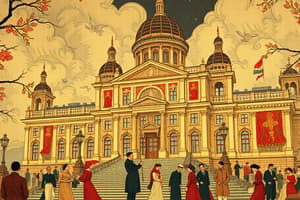Podcast
Questions and Answers
Which of the following best describes the Bolshevik ideology's core tenets?
Which of the following best describes the Bolshevik ideology's core tenets?
- A political philosophy focused on individual liberty and free-market economics to stimulate economic growth and social mobility.
- A revolutionary doctrine advocating for the violent overthrow of the bourgeoisie and establishment of a proletarian dictatorship. (correct)
- A system promoting gradual reform within a capitalist framework to improve worker conditions.
- An ideology emphasizing national unity and traditional values above class struggle and international revolution.
What was the primary significance of the Treaty of Brest-Litovsk for the early Soviet government?
What was the primary significance of the Treaty of Brest-Litovsk for the early Soviet government?
- It marked the beginning of a long-lasting peace and economic cooperation between Russia and Germany.
- It triggered immediate foreign intervention and the collapse of the Bolshevik regime.
- It allowed the Soviet government to consolidate power by withdrawing from World War I, albeit with significant territorial losses. (correct)
- It solidified the Soviet Union's alliance with the Allied powers against Germany.
What was the Sovnarkom's role in the early Soviet government?
What was the Sovnarkom's role in the early Soviet government?
- It was the highest executive authority, responsible for implementing policies and decrees. (correct)
- It served solely as a legislative assembly, drafting laws for approval by local soviets.
- It functioned primarily as a ceremonial body with little actual political influence.
- It acted only as a judicial body interpreting the constitution and resolving legal disputes.
Which of the following factors contributed most significantly to Stalin's emergence as the leader of the USSR by the late 1920s?
Which of the following factors contributed most significantly to Stalin's emergence as the leader of the USSR by the late 1920s?
Which of the following policies was a hallmark of Stalin's economic transformation of the Soviet Union?
Which of the following policies was a hallmark of Stalin's economic transformation of the Soviet Union?
What was a predominant feature of the political transformation under Stalin?
What was a predominant feature of the political transformation under Stalin?
What role did propaganda play in the Soviet Union under Stalin?
What role did propaganda play in the Soviet Union under Stalin?
What role did ideology play in Soviet foreign policy between 1917 and 1941?
What role did ideology play in Soviet foreign policy between 1917 and 1941?
Flashcards
Bolshevik Ideology
Bolshevik Ideology
A political theory guiding the Bolshevik Party, based on Marxism.
October Coup 1917
October Coup 1917
The armed insurrection led by the Bolsheviks to seize control of the government.
New Economic Policy
New Economic Policy
Economic policy introduced by Lenin to recover the economy post-Civil War.
Stalin's Rise to Power
Stalin's Rise to Power
Signup and view all the flashcards
Collectivization
Collectivization
Signup and view all the flashcards
Five-Year Plans
Five-Year Plans
Signup and view all the flashcards
Totalitarianism
Totalitarianism
Signup and view all the flashcards
Soviet Foreign Policy (1917-1941)
Soviet Foreign Policy (1917-1941)
Signup and view all the flashcards
Study Notes
Russia and the Soviet Union (1917-1941)
- Bolshevik ideology, in theory and practice, was a key factor in the historical context
- Competing visions within the Bolshevik Party and the USSR were pivotal
- Bolshevik consolidation of power involved the October Coup of 1917, the Treaty of Brest-Litovsk, the Civil War, and the New Economic Policy
- Political and economic transformations were significant, leading to fundamental shifts
- Social and cultural transformations were part of the broader historical context
- Stalinism's nature and impact significantly shaped the Soviet Union
- The aims, nature, and effectiveness of Soviet foreign policy played a crucial role in shaping international relations
Bolshevik Consolidation of Power
- Bolshevik ideology, October 1917 coup, early Soviet government, Treaty of Brest-Litovsk, the Civil War, and the introduction of the New Economic Policy all contributed to the consolidation of power
- These events led to pivotal moments in the transformation of Russia and the development of the Soviet Union
The Power Struggle Following Lenin's Death
- The power struggle following Lenin's death involved key figures like Stalin, Trotsky, and others
- The struggle shaped the emergence of Stalin as leader, marking a critical shift in Soviet leadership
The Soviet State Under Stalin
- Stalin's leadership established dictatorship and totalitarianism in the USSR
- Economic transformation under Stalin involved collectivisation and five-year plans, drastically impacting Soviet society
- Political transformation involved the growth of the Party, use of terror, show trials, and gulags, as well as propaganda and censorship
- Significant social and cultural changes occurred under Stalin's rule
Soviet Foreign Policy (1917-1941)
- The nature of Soviet foreign policy between 1917 and 1941 was a key aspect of international relations
- The role of ideology was critical in shaping Soviet foreign policy during this period.
Studying That Suits You
Use AI to generate personalized quizzes and flashcards to suit your learning preferences.





